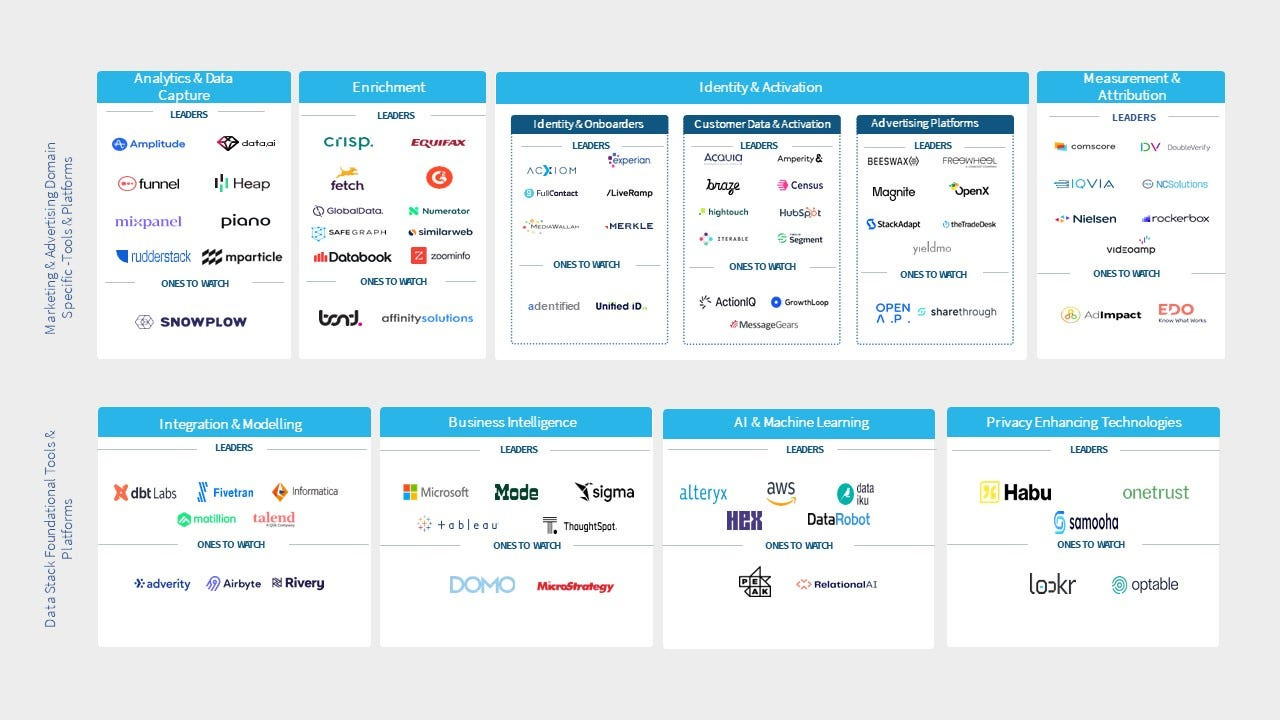[6]Evolving Market Map — Marketing Stack with GenAI
How is marketing transforming with search cannibalization and changes in user interfaces?
LinkedIn reported that “77% of CMOs globally feel under pressure to prove greater short-term ROI on their marketing campaigns” and that “90% of marketers say improving CFO understanding of ROI is key to bolstering future budgets.” This tells us that marketing teams want to deliver the ROI on their investments in the marketing stack. Other factors that strengthen this are as follows:
As it gets difficult to acquire new customers, companies will double down on retaining existing customers to protect their revenue base. Buyers need to justify tech purchases more than ever.
Market will see significant downward pricing pressures with new pricing models — Seat Based Pricing, Usage-Based Pricing, and Staff Augmentation Pricing becoming prominent. This trend will favour lower-priced solutions at the expense of higher-priced competitors.
To capture more revenues from existing customers, companies will step into each other’s lanes with new features or products. Market will reward a shift from “Best of Breed SaaS” to “All in One”
What are the different stages of the SaaS funnel?
B2B marketers use Marketing Qualified Leads (MQLs) as the core metric to measure the performance of their funnel. However, there are many moving parts involved in both digital and offline channels, making it difficult to maintain consistency in the state of your funnel. With increased cost pressures and ROI expectations on marketing dollars, there is a need for tools that can automate certain functions within marketing teams using GenAI to solve predictable outcomes. The key to this is data, but it's not enough to just have data. It should be a single source of truth that can be integrated and analyzed to make intelligent decisions on your content, email outreach, campaign messaging, SEO, CRO, outbound motion, and other go-to-market activities.
First of all, What is MarkTech?
MarkTech is a term used to describe software tools that are used by marketing teams to attract and retain customers. It involves handling customers' data, its storage, and analytics.
Evolving Marketing Stack
Below is a market map of the modern marketing data stack. There needs to be a clear distinction between the foundational data technologies that every company needs across functions and teams (such as data integration, business intelligence, and AI) and the marketing and advertising-specific technologies that sit atop that foundation (such as identity, activation, and specific measurement tools).
Breaking down data in silos is still very much a top priority for a large chunk of the market, especially those who are slow to adopt the stack.
Top Trends in MarkTech Stack and Shift Due to GenAI :
1)AI/ML: LLM emergence — Marketing is one of the most impacted fields due to LLMs. GenAI is going to automate and improve a wide range of marketing functions, including:
a)Ad campaign optimization: Insights to improve audience segmentation and ad placement will emerge, improving conversion rates and campaign ROI. Product discovery will happen through AI as it is better and faster. As AI-assisted search comes into the mainstream through apps such as Perplexity or Microsoft Bing Chat, Prompt discovery will become important with Search discovery. Search engine optimization (SEO) experts will work along with Prompt Engineering Optimization (PEO) specialists. I see that the Search space will evolve on a hybrid stack where you’ll have a system that will direct the queries to both vector and legacy search. Matching will be done individually while ranking will be done across both sets to provide the best results on the Search Engine Results Pages(SERP).
b)Content generation: According to Gartner, by 2026, 80% of the creative roles will be tasked with harnessing GenAI to achieve differentiated results. LLMs make serviceable text quick and cheap. These tools can write blogs, ad copy, web pages, and emails, along with image and video generation. Some of the interesting products in this category include Copy.ai, Jasper, Writer, Anyword, Regie.ai, and Pepper Content.
The average marketer will be able to ship images and some form of video this year. There will be tools that will be able to ship production-ready images and videos, such as tools like Pika, Runway, Synthesia, and Skippr. Marketers will see the explosion of No Code AI-enabled products to reduce manual labor for creating content.
c)Large language processing: Chatbots will come into the mainstream, providing solutions to your customer support teams as they better interpret and respond to human language. NLP-powered sentiment analysis can also help marketers gauge target customers’ opinions and sentiments toward their brand or campaigns.
d)Customer personalization: LLMs can take everything you know about your customers or similar customers and tailor campaigns and interactions based on behavioral patterns. The outcome: more effective campaigns, happier customers, better campaign results. E.g. Mutiny.
After capturing leads, marketers use personalization techniques such as email personalization and outreach. However, with the increasing use of AI in marketing, the question arises: what is true personalization? As AI makes personalized marketing more widespread, it can also make it feel less personal. Consumers may understand that it's personalized, but they may not feel a personal connection with the brand. By using external data to create personalized content like emails, videos, and web pages, AI can improve post-lead capture conversion rates and reduce costs. However, it may become difficult to increase traffic or leads due to cannibalization of search, as seen in Stack Overflow's 50% decrease in traffic. This learned behavior may become even more common, with Google potentially accelerating it.
e)Market research and competitive notes: Tweets, online reviews, market research reports, news, and publicly available data sets fed into LLMs will help marketing teams on their research journey. The algorithm can process all of it to give marketers deep insights into consumer trends and sentiment, the competitive landscape, and shifting market opportunities. Tools such as Wokelo.ai offer market research and specific industry insights, reducing the time to market.
2)Adtech/MarkTech Convergence: Traditionally, advertising and marketing teams usually operated separately or are at least not tightly integrated. The ecosystem of tools to manage paid channels was, therefore, different from tools to manage owned channels. To manage paid channels, we have ad servers, exchanges, and social media platforms, and to manage owned channels, we have CRMs, email marketing systems, SEO, etc. This convergence has been largely because Data about potential customers’ intent, interests, and behaviors is scattered ineffectively across multiple solutions used by marketers.
According to Google’s latest update, it has been confirmed that starting in 2024, user information will no longer be shared with advertisers. This means that marketers will have to rely solely on first-party data from their website, virtual and in-person events, newsletters, or social media for their cookieless marketing campaigns. Businesses that are not prepared for this will see lesser ROI on their marketing campaigns. This will create a need for platforms that work using AI for intelligent segmenting.
Open Questions:
At the core of marketing is data, so let’s think about the data as every SaaS company becomes AI native. Questions that become prominent are — what is the nature and structure of these data? Does that change, and how?
How would interfaces change? The concept of Product Analytics looks very different in the world if the product interface becomes a chat interface
How does intelligent segmentation look like? Another version of it is how you can enable people to work with this data using natural language?
Will newcomers compete with incumbents by solving niche use cases? If Yes, then Would they be ingrained in workflows creating strong stickiness around them? or Will they go out of the market as thin wrappers?
Data Sources: Snowflake’s modern data stack
If you found this piece helpful or interesting, don’t hesitate to share it with your network.




